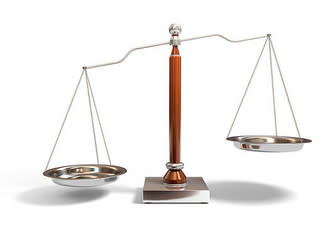Why You Need to Diversify Your Investments
The first mistake of first time investors is not diversifying. This is what happens when a newbie gets a “hot stock tip”, and then proceeds to pour ever last cent into it. In this article, we’ll explain why that’s good. For wiping out your entire investment, that is. So stay safe and diversify instead:

Throwing all your money behind a single stock tip can wipe you out.
What is Diversification?
Imagine a terrible accident happens at the zoo: A grizzly bear escapes the cage.
It sets eyes on you, and realizes you’re basically a steak in a T-Shirt. It chases, you run.
Now what would you say your odds are? Bears hit 60 miles an hour, so unless you often get speeding tickets while jogging, I’d say nil.
But now imagine you’re not alone. You’re in a crowd of hundreds of tourists, who all scatter and run.
In this scenario, your chances of survival rise exponentially. Odds are, the bear will get one of the other tourists instead of you. And if everyone’s fleeing in different directions, that’s even better: A bear can only run in one direction at a time.
The same principle applies to portfolio diversification.
By putting your money in many different stocks, all in different industries, it’s like having a crowd of scattered tourists instead of being a lone runner. Even if disaster strikes one asset, most of the others will get away.
How Does a Diversified Portfolio Look?
Diversification is about investing in a range of different, lowly correlated asset classes.
A diversified portfolio tends to have one or more of the following:
A Mix of Different Asset Classes
Investments in Lowly-Correlated Industries
Assets with Varying Rates of Risk and Return
1. A Mix of Different Asset Classes
Diversification means investing in different asset classes. For example, say you have a bit in stocks, a bit in bonds, some physical gold, and even some property.
Should the property bubble bursts, your gains in gold, stocks, etc. might offset your property losses.
Likewise, if the stock market crashes, your gains in gold, property, etc. can offset the loss.
Each asset class is prone to its own ups and downs; but it’s highly unlikely that all of them will fall at the same time. So by having a bit of each, you lower the chance of your whole portfolio crashing because one asset had a bad year.
2. Investments In Lowly-Correlated Industries

Some groups of assets tend to move in the same direction. Diversify to avoid that.
Let’s say I buy gold jewellery, some gold Exchange Traded Funds (ETFs), and then invest in a gold mining company. Is my portfolio diversified?
Well technically, those are not all the same assets. But there’s a high degree of correlation between them.
Consider what happens if gold prices were to fall:
My jewellery would be worth less, my gold ETFs would generate lower returns, and the gold mining company would make less profit, thus causing its share prices to drop.
So even though I invested in different types of assets, I wasn’t truly diversified; the assets were too closely interrelated.
Proper diversification means investing in lowly correlated assets. For example, investing in health care, telecommunications services, and consumer staples at the same time.
Because these industries have some distance from each other, the fall of one probably won’t pull down the others.
3. Assets With Varying Rates of Risk and Return
When one asset underperforms, gains in another can make up the difference.
It’s possible to invest solely in low risk assets (e.g. blue chip stocks, investment grade bonds). It’s also possible to invest entirely in high risk assets (e.g. penny stocks, high yield bonds).
The “low risk only” approachcan make your money stagnate. See, low risk often (but not always) means low returns. Sometimes, the returns are so bad, even the inflation ratebeats them.
If the inflation rate is 4%, for example, and your portfolio generates only 3% returns, you’re indirectly losing 1%.
But then we have the “high risk only” approach, where you treat the stock market as one big casino. This method puts even your principal (the amount initially invested) at risk.
The solutionis to mix the two: Get assets with both low and high rates of return. Underperformance in one asset can be offset by gains in another.
How to Diversify
There isn’t one best way to diversify. It depends entirely on the individual investor’s goals.
There is no single, optimal way to diversify.
Optimization depends on your individual goals. Your portfolio must be varied based on your investment horizon (how long you want to stay invested), and how much you want to make in the end.
New investors should talk to their stock broker, or to a qualified financial adviser, regarding their goals. Don’t spread your money among random choices, and imagine you’re protected by diversification. You could end up “protecting” yourself from profit too.
A MoneySmart Investment Series in collaboration with SGX
This is the fourth article of a 6-part series, focusing on investment for beginners. For more on starting your investment plans, like SGX on Facebook and subscribe to SGX My Gateway here. In this series, we’ll be introducing you to the most basic elements of the stock market, and how a non-expert can still profit from it. If you are new to this series, do read the first three parts here:
Part 1: Why the Smart Money’s on Investors, not Savers
Part 2: What Kind of Investor Are You?
Part 3: The Beginner’s Guide to Investment Products
How do you diversify your portfolio? Comment and let us know!
Image Credits:
Iman Mosaad, Mr.Thomas, sjcockell, winnifredxoxo, Ivan McClellan Photography
Get more Personal Finance tips and tricks on www.MoneySmart.sg
Click to Compare Singapore Home Loans, Car Insurance and Credit Cards on our other sites.
More From MoneySmart




